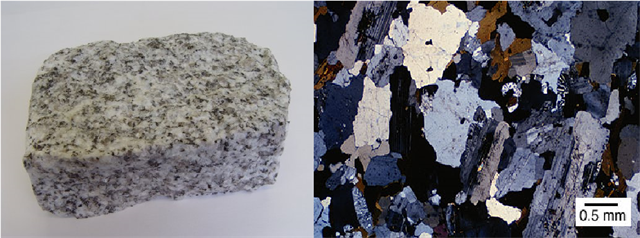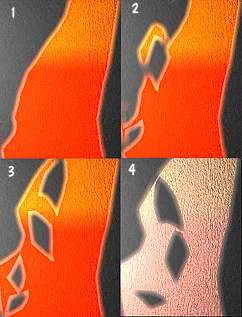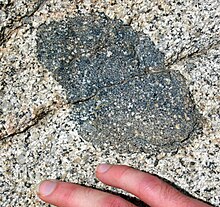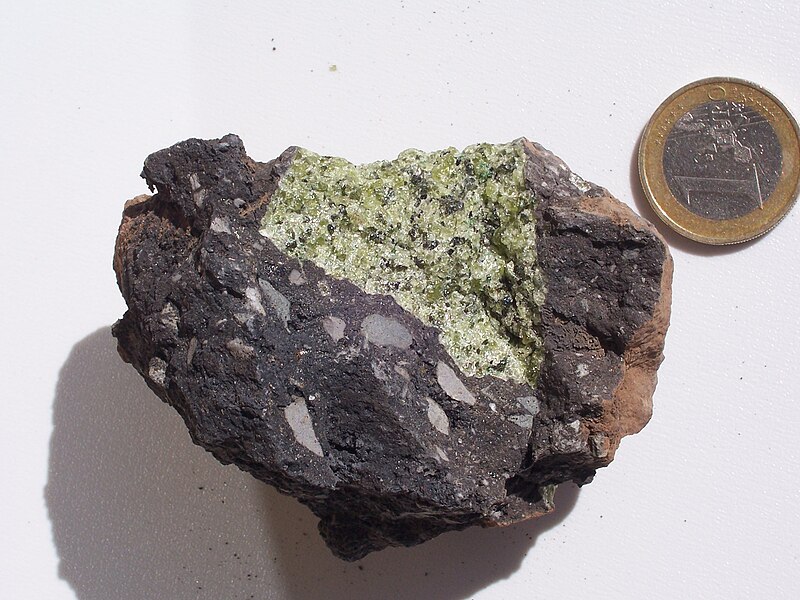

Xénolithe ?!?
Xénolithe (ou xénolite) est un terme géologique venant du grec "xenos" qui signifie "étranger" et de "lithos" qui signifie "pierre". C'est donc une enclave dans une roche magmatique ou encore un morceau de roche piégé dans un autre type de roche.
Cette EarthCache va vous montrer où vous pouvez en observer plusieurs : sur le socle de la statue de Roland Garros !
Formation :
Les roches magmatiques contiennent très souvent des enclaves de roches différentes, ces enclaves sont des fragments de roches rencontrés par le magma lors de sa formation (roches plutoniques) ou lors de sa remontée dans la cheminée volcanique (roches volcaniques). Or les minéraux et cristaux à l'origine de la roche hôte et du xénolithe ne sont pas identiques, ils ne cristallisent donc pas de la même façon ce qui explique la présence de roches l'une dans l'autre..
Les roches plutoniques comme le granite et la diorite se forment en profondeur dans des chambres magmatiques où le magma subit un refroidissement et une cristallisation de ses minéraux lents. Ce qui est à l'origine de la structure grenue des roches plutoniques dont les minéraux sont visibles à l'oeil nu.

Observation de granite à l'oeil nu et au microscope polarisant (on distingue très bien les minéraux jointifs)
|
Schéma de l'arrachage des xénocristaux de la paroi de la chambre magmatique
|
C'est pendant son stockage et son refroidissement dans les chambres magmatiques, que des xénocristaux (=cristaux différents de ceux du magma) des parois de la chambre magmatique peuvent se mêler au magma pour former des xénolithes.
Ces roches sont ensuite remontées à la surface par des mouvements tectoniques.
|
|
Les roches volcaniques comme l'andésite et la rhyolite ne se forment pas en profondeur en effet leur structure est microlitique, ce qui signifie que les cristaux les constituant sont difficilement visibles à l'oeil nu et qu'elles sont composées d'une pâte vitreuse (verre non cristallisé) contenant de petits cristaux (microlithes).
Or ce type de structure est caractéristique d'une cristallisation et d'un refroidissement rapides du magma. Ce qui est uniquement possible en surface lors d'une éruption volcanique.
 Observation d'andésite à l'oeil nu et au microscope polarisant
Observation d'andésite à l'oeil nu et au microscope polarisant
(on distingue très bien le verre et les minéraux non jointifs)
 |
C'est lors de cette éruption et surtout lors de la remontée du magma à la surface de la Terre que le magma peut arracher des xénocristaux de la paroi des fissures dans lesquelles il se déplace, ce qui peut former des xénolithes. |
| Schéma de l'arrachage des xénocristaux de la paroi de la cheminée volcanique lors d'une éruption volcanique |
|
|
Comment reconnaître des xénolithes ?
De manière générale, les xénolithes sont visibles grâce à leur couleur différente de celle du reste de la roche. Leur densité est également différente de la roche hôte.
La taille des xénolithes est très variable : de quelques millimétres à plusieurs mètres pour les plus remarquables...
On identifie les xénolithes et les xénocristaux par les noms des deux roches impliquées :



À gauche : Xénolithe de gabbro dans du granite
Au centre : Xénolithe de péridotite (vert) dans une bombe volcanique
À droite : Large et inhabituelle xénolithe de grès
Importance des xénolithes :
Les xénolithes et xénocristaux sont très importants pour les géologues car ils fournissent des informations précieuses : puisqu'en étudiant la composition des roches, les scientifiques sont capables de déterminer à quelle profondeur la roche s'est formée et donc de connaître la composition du manteau terrestre.
Et comme il nous est impossible de nous rendre à de telles profondeurs (plusieurs centaines de kilomètres à l'intérieur de la Terre), sans les xénolithes certaines informations sur la croûte terrestre seraient impossibles à obtenir.

Rappel concernant les Earthcaches : Il n'y a pas de conteneur à rechercher ni de logbook à signer. Il suffit de se rendre sur les lieux et de répondre aux questions du propriétaire de la cache puis de lui envoyer vos réponses via son profil par mail ou par le centre de messagerie de geocaching.com pour validation. Happy Earthcaching!
Pour valider cette EarthCache :
1. Mesurer la taille de l'une des plus grosses enclaves située en haut à gauche (voir photo).
2. Donner moi le nom des deux types de roches qui forment ce xénolithe.
3. En vous aidant de la description et de vos observations sur place, donnez-moi les conditions de formation de la roche hôte. Justifier votre réponse.
4. Déduisez-en comment cette roche a pu être incrustée dans une autre roche pour former un xénolithe.
En option : une photo de vous et/ou de votre GPS. (pas de spoiler de l'enclave à mesurer, merci !)


Xenolith?!?
Xenolith is a geological term from greek "xenos" which means "foreign" and from "lithos" which means "stone". So a xenolith is an inclusion in a magma rock or in other words a piece of rock trapped in another kind of rock.
Formation:
Most of the time magma rocks contain inclusions of another different rock, these inclusions are pieces of rocks met by the magma during its formation (plutonic rocks) or during its raising in the volcanic chimney (volcanic rocks). But as the minerals and crystals at the origin of both rocks are not the same, they didn't crystallise on the same way and that's why there is a rock mixed in another...
Plutonic rocks as granite or diorite are formed on depth in magmatic chambers where the magma cool and crystallise slowly. This is at the origin of the phaneritic textureof the plutonic rocks whose mineral grains are large enough to be seen with the naked eye or a hand lens.

Photo of granite and observation with a polarizing microscope (we can see the mineral grains which are joined)
|
Schéma of the uprooting of xenocrysts from the walls of the magmatic chamber
|
This is during its cooling and its stock in the magmatic chambers that xenocrysts (=crystals which are differents from those of the magma) of the walls of the magmatic chamber can be mixed with the magma to form xenolith.
Then these rocks are climbed up to the surface thanks to tectonic movements.
|
|
Volcanic rocks as andesite or rhyolithe are not formed on the depth in fact their texture is aphanitic, which means that the grains and the crystalline structure is too fine to be seen by the unaided eye.
Such rock is formed when the material solidifies at or near the surface so that the cooling is rather rapid. Under these conditions there is not enough time for the growth of large crystals
 Photo of andesite and observation with a polarizing microscope (we can see the mineral grains and the glassy matrix)
Photo of andesite and observation with a polarizing microscope (we can see the mineral grains and the glassy matrix)
 |
This is during the eruption and especially during the raising of the magma to the surface of the Earth that magma uproots xenocrysts from the walls of the magmatic chimney which forms xenoliths. |
| Schéma of the uprooting of xenocrysts from the walls of the magmatic chimney during the volcanic eruption. |
|
|
How do you recognize xenoliths?
Generally, xenoliths are visible through their different colors than the rest of the rock, they also have a density different from the surrounding igneous rock.
The size of the xenoliths can be very variable: from some millimeters to several meters for the most outstanding xenoliths... We identify the xenoliths and the xenocrysts by the names of the two rocks involved:



Left : Gabbroic xenolith in a granite.
Center : Peridotite (green) mantle xenolith within a volcanic bomb.
Right : Large and rather unusual xenolith of sandstone.
Importance of the xenoliths:
Xenoliths and xenocrysts are very important for geologists indeed they give precious informations: thanks to the study of the composition of the rocks, scientists are able to determin on which depth the rock was formed and so to know the composition of the Earth's mantle.
As it is impossible for us to go to such depths (several hundreds of kilometers inside of the Earth), some informations on the Earth's crust would be impossible to obtain without xenoliths.

Reminder on Earthcaches : There is no container or logbook on the given coordinates. Just visit the site and answer the questions by e-mail or by the messaging center. There is no need to wait for my reply, feel free to log immediately after. If the answers are incorrect, I will let you know. Happy EarthCaching!
To valid this EarthCache:
1. Measure the size of one of the biggest inclusions located at the top left. (see picture).
2. Give me the name of the two kinds of rocks which form this xenolith.
3. With the help of the listing and of your observations, say me what are the conditions of the formation of the rock in which the inclusion is. Justify your answer.
4. So deduce how the rock was included in the other to form this xenolith.
In option : a picture of you and/or of your GPS (no spoiler of the inclusion, thanks!)